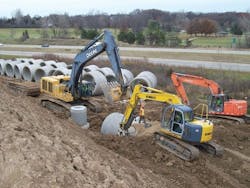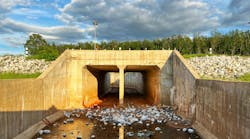Constructing Critical Infrastructure With Concrete
Deicing operations at the Gerald R. Ford International Airport (GFIA) in Grand Rapids, Mich., contributed to a nuisance biofilm condition in a tributary of the Thornapple River that received storm water runoff.
Among the project requirements were rerouting storm water from the airport’s north detention basin to a new outfall at the Thornapple River, and reconfiguring the airport’s west apron storm water system to consolidate runoff from all major existing and future aircraft deicing areas. Reinforced concrete pipe was specified by GFIA to convey storm water and deicing runoff to an engineered natural treatment system that utilizes naturally occurring bacteria and other organisms to break down deicers and other pollutants, and then convey that from the treatment facility to the new outfall. During seasons when deicing activity is not required, the system is designed to allow base flow amounts of storm water into the tributary and channel heavier flows to the new detention basin and treatment facility. From there, the heavier flows are discharged to the receiving river.
The pipeline alignment required crossing under a railway, a local road, an expressway, a golf course and a portion of a river. Manholes, drop structures and overflow energy dissipation structures were included. The concrete pipeline passes over two concrete box culverts that channel streams to the river.
This storm water treatment system enhances the quality of the natural environment with a design for collecting and treating propylene glycol. GFIA is owner and operator of the system.
Download: Here


